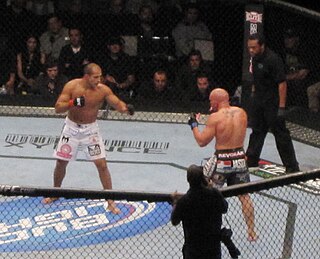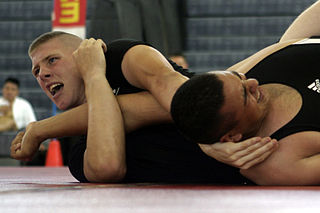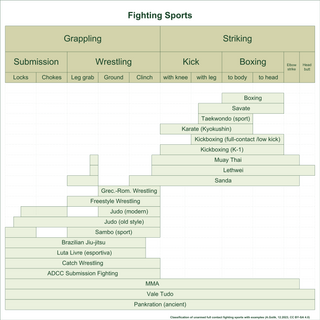
Martial arts are codified systems and traditions of combat practiced for a number of reasons such as self-defence; military and law enforcement applications; competition; physical, mental, and spiritual development; entertainment; and the preservation of a nation's intangible cultural heritage.

Pankration was an unarmed combat sport introduced into the Greek Olympic Games in 648 BC. The athletes used boxing and wrestling techniques but also others, such as kicking, holds, joint-locks, and chokes on the ground, making it similar to modern mixed martial arts. The term comes from the Greek παγκράτιον, meaning 'all of power', from πᾶν (pan) 'all' and κράτος (kratos) 'strength, might, power'.

Mixed martial arts (MMA) is a full-contact combat sport based on striking, grappling and ground fighting, incorporating techniques from various combat sports from around the world. The first documented use of the term mixed martial arts was in a review of UFC 1 by television critic Howard Rosenberg in 1993.
The following outline is provided as an overview of and topical guide to martial arts:

Submission wrestling, also known as submission grappling, submission fighting or simply grappling, is a competitive martial art and combat sport that focuses on ground fighting and submission techniques. It is a hybrid discipline that incorporates elements of various grappling arts such as various wrestling styles, judo, and Brazilian jiu-jitsu. Submission wrestling is practiced both as a competitive sport and as a training method for self-defence and mixed martial arts (MMA).

Wrestling is a martial art and combat sport that involves grappling with an opponent and striving to obtain a position of advantage through different throws or techniques, within a given ruleset. Wrestling involves different grappling-type techniques such as clinch fighting, throws and takedowns, joint locks, pins, and other grappling holds. Many different wrestling techniques have been incorporated into martial arts, combat sports, and military systems. Wrestling is genuine competition; professional wrestling is athletic theatre.

Hand-to-hand combat is a physical confrontation between two or more persons at short range that does not involve the use of ranged weapons. The phrase "hand-to-hand" sometimes include use of melee weapons such as knives, swords, clubs, spears, axes, or improvised weapons such as entrenching tools. While the term "hand-to-hand combat" originally referred principally to engagements by combatants on the battlefield, it can also refer to any personal physical engagement by two or more people, including law enforcement officers, civilians, and criminals.

A combat sport, or fighting sport, is a contact sport that usually involves one-on-one combat. In many combat sports, a contestant wins by scoring more points than the opponent, submitting the opponent with a hold, disabling the opponent, or attacking the opponent in a specific or designated technique. Combat sports share a long history with the martial arts.

Carlos Newton is an Anguillian-born Canadian retired mixed martial artist. He is a former UFC Welterweight Champion and Pride FC Japan MMA Legend. Known as "The Ronin", he competed worldwide in the biggest MMA organizations including UFC, Pride FC, IFL, K-1, Shooto and most recently W-1. He is a 3rd Degree Brazilian Jiu-Jitsu Black Belt alongside his coach Terry Riggs under Renzo Gracie, at Warrior MMA in Newmarket, Ontario. Newton has always been considered a fan favourite and a "Submission Master" and has dubbed his personal fighting style — an amalgam of Brazilian Jiu-Jitsu, Judo, Wrestling, Karate, and Boxing — as "Dragon Ball Jiu-Jitsu" in tribute to Dragon Ball, a Japanese manga and anime franchise. Newton is one of only a few MMA athletes to ever be allowed to compete in the UFC and Pride FC at the same time. In Canada he was the first Canadian UFC Champion at UFC 31 (Welterweight) defeating Pat Miletich.

Enson Shoji Inoue is a Japanese-American jiu-jitsu practitioner and retired professional mixed martial artist. A professional competitor from 1995 until 2010, he fought for the PRIDE Fighting Championships, the UFC, Shooto, and Vale Tudo Japan. He was the first and only Shooto Heavyweight Champion, and was a finalist in the Lightweight category at UFC 13.
Hybrid martial arts, also known as hybrid fighting systems or sometimes eclectic martial arts or freestyle martial arts, referred to as mixed martial arts or fighting systems that incorporate techniques and theories from several martial arts. While numerous martial arts borrow or adapt from other arts and to some extent could be considered hybrids, a hybrid martial art emphasizes its disparate origins.

Joe Lewis was an American martial artist, professional kickboxer and actor. Originally a practitioner of Shōrin-ryū karate and champion in point sparring competitions, he became one of the fathers of full contact karate and kickboxing in the United States, and is credited with popularizing the combat sport in North America.

Mearion Shonie Bickhem III, better known as Shonie Carter, is an American mixed martial artist. He is a former WEC Welterweight Champion, a UFC veteran, and a contestant on The Ultimate Fighter 4 reality show. He has also competed in Pancrase, Shooto, King of the Cage, M-1 Global, KSW, and Bellator. He is known for his flashy dress, colorful vocabulary, outlandish personality and use of the spinning backfist in competition.

The lei tai is an elevated fighting arena, without railings, where often fatal weapons and bare-knuckle martial arts tournaments were once held. "Sanctioned" matches were presided over by a referee on the platform and judges on the sides. Fighters would lose if they surrendered, were incapacitated, or were thrown or otherwise forced from the stage. The winner would remain on the stage unless ousted by a stronger opponent. If there were no more challengers, they would become the champion. Private duels on the stage had no rules and were sometimes fought to the death.
This martial arts timeline is designed to help describe the history of the martial arts in a linear fashion. Many of the articles for particular styles have discussions of their history. This article is designed to help visualize the development of these arts, to help better understand the progression of the separate styles and illustrate where they interrelate.

Shaolin Kenpo Karate is a martial art style that combines the Five Animals of Shaolin Kung Fu (Shaolinquan), the core competency of Kempo, the hard-hitting linear explosiveness of traditional Karate, as well as the power of Western boxing and the felling and grappling arts of Jujutsu, Chin Na, and Mongolian wrestling. This system was founded and developed by Fredrick J. Villari, who devised a hybrid system which integrated the four ways of fighting: striking, kicking, felling, and grappling to eliminate the inherent weakness of martial arts systems that focus on just one or two of fighting techniques.
Openweight, also known as Absolute, is an unofficial weight class in combat sports and professional wrestling. It refers to bouts where there is no weight limit and fighters with a dramatic difference in size can compete against each other. It is different from catch weight, where competitors agree to weigh in at a certain amount without an official weight class. While weight classes are usually mandatory now, openweight competition was the norm for combat sports since antiquity and continues into the modern day.

Glenn R. Keeney was an American martial artist. He was born to Walter Russell and Lucy Puckett Keeney in Anderson, Indiana in 1942, and began his karate training in 1957.

Jayson Patino is an American Brazilian Jiu Jitsu practitioner who holds a black belt under Ricardo Liborio of American Top Team. He is known for his competitive achievements in FILA Pankration Submission, ADCC, IBJJF, and other grappling tournaments. He is also owner of American Top Team East Orlando.














